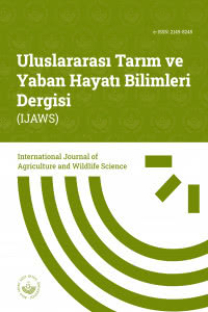Effects of Rootstocks on Sugar and Organic Acid Contents of 'Deveci' Pear
Effects of Rootstocks on Sugar and Organic Acid Contents of 'Deveci' Pear
___
- Chen J., Wang Z., Wu J., Wang Q and Hu X., 2007. Chemical compositional characterization of eight pear cultivars grown in China. Food Chemistry, 104(1): 268-275.
- Colaric M., Sturm K and Stampar F., 1999. Seasonal variation of sugars and organic acids in apple (Malus domestica Borkh.) in different growing systems. Plant Physiology, 39: 91-96.
- Colaric M., Stampar F., Solar A and Hudina M., 2006. Influence of branch bending on sugar, organic acid and phenolic content in fruits of 'Williams' pears (Pyrus communis L.). Journal of the Science of Food and Agriculture, 86: 2463-2467.
- Dolenc K and Stampar F., 1997. An investigation of the application and conditions of analyses of HPLC methods for determining sugars and organic acids in fruits. Research reports of Biotechnical Faculty, University of Ljubljana; Ljubljana, Slovenia, 69: 99-106.
- Dziezak JD., 2003. Acids. Encyclopaedia of Food Sciences and Nutrition (2nd edn) (Eds. B. Caballero, LC. Trugo and PM Finglas). Academic Press, London, pp. 7-17.
- Ercisli S., 2004. A short review of the fruit germplasm resources of Turkey. Genetic Resources and Crop Evolution, 51: 419-435.
- FAO 2017. The FAOSTAT website. http://www.faostat.org. [Access: May 10, 2017].
- Gundogdu M., Ozrenk K., Ercisli S., Kan T., Kodad O and Hegedus A., 2014. Organic acids, sugars, vitamin C content and some pomological characteristics of eleven hawthorn species (Crataegus spp.) from Turkey. Biological Research, 47: 21-26.
- Hancock JF and Lobos GA., 2008. Pears. In: Temperate Fruit Crop Breeding: Germplasm to Genomics. Berlin, Germany, Springer, pp. 299-336.
- Hudina M and Stampar F., 2000. Sugars and organic acids contents of European (Pyrus communis L.) and Asian (Pyrus serotine Rehd.) pear cultivars. Acta Aliment, 29: 217-230.
- Jackson JE., 2003. Biology of apples and pears. Cambridge University Press, Cambridge, UK.
- Muir JG., Rose R., Rosella O., Liels K., Barrett JS., Shepherd SJ and Gibson PR., 2009. Measurement of Short-Chain Carbohydrates in Common Australian Vegetables and Fruits by High-Performance Liquid Chromatography (HPLC). Journal of Agricultural and Food Chemistry, 57: 554-565.
- Nour V., Trandafr I and Ionica ME., 2010. Compositional Characteristics of Fruits of several Apple (Malus domestica Borkh.) Cultivars. Natulae Botanicae Horti Agrobotanici Cluj-Napoca, 39(3): 228-233.
- Ozcagiran R., Unal A., Ozeker E and Isfendiyaroglu M., 2004. Pear. Temperate Fruit Trees (Pome Fruits) Volume-II. Ege University Agriculture Faculty Publications Number: 556, Bornova-Izmir, Turkey, pp. 73-126 (in Turkish).
- Peck GM., Andrews PK., Reganold JP and Fellman K., 2006. Apple orchard productivity and fruit quality under organic, conventional, and integrated management, HortScience, 41: 99-107.
- Roth E., Berna A., Beullens K., Lammertyn J., Schenk A and Nicolai B., 2007. Postharvest quality of integrated and organically produced apple fruit. Postharvest Biology and Technology, 45: 11-19.
- Sen F., Ünal A and Arda E., 2009. Bursa yöresinde yetiştirilen 'Deveci' armut çeşidinin yöresel olgunluk standartlarının ve depolama durumlarının saptanması üzerinde bir araştırma, Anadolu, 9(2): 33-48.
- Sha S., Li J., Wu J and Zhang S., 2011. Characteristics of organic acids in the fruit of different pear species. African Journal of Agricultural Research, 6(10): 2403-2410.
- Silva MB., Andrade PB., Mendes GC., Seabra FM and Ferreira MA., 2002. Study of the Organic Acids Composition of Quince (Cydonia oblonga Miller) Fruit and Jam. Journal of Agricultural and Food Chemistry, 50: 2313-2317.
- TSMS 2017. Turkish State Meteorological Service. https://mgm.gov.tr/eng/forecast-cities.aspx?m= SAMSUN. [Access: May 15, 2017].
- ISSN: 2149-8245
- Başlangıç: 2015
- Yayıncı: BOLU ABANT İZZET BAYSAL ÜNİVERSİTESİ > ZİRAAT VE DOĞA BİLİMLERİ FAKÜLTESİ
Hammaç Mustafa AYKUTLU, FATİH ÖNER
Effects of Rootstocks on Sugar and Organic Acid Contents of ‘Deveci’ Pear
Ahmet ÖZTÜRK, Burhan Öztürk, Osman GÜL
A Temporal Status of Some Game Bird Population in Bolu, Turkey
ŞEYDA ÇAVUŞOĞLU, KORAY ÖZRENK, İmameddin OTURMAK1
ÜNAL ZEYBEKOĞLU, ABDURRAHMAN SAMİ KOCA, ÇETİN MUTLU
Bolu Yaban Hayatında Bazı Av Kuşlarının Temporal Statüsü
Ordu İli Yerel Mısır (Zea mays L.) Genotiplerinin Morfolojik Karakterizasyonu
Effects of Rootstocks on Sugar and Organic Acid Contents of 'Deveci' Pear
Osman GÜL, Burhan ÖZTÜRK, Ahmet ÖZTÜRK
The Effects of Stocking Density on Some Blood Stress Parameters of Meat Turkeys
SABRİ ARDA ERATALAR, Rüveyde Akbay
Farklı Mısır (Zea mays L.) Alt Türlerinin Körpe Mısır Özelliklerinin Karşılaştırılması
